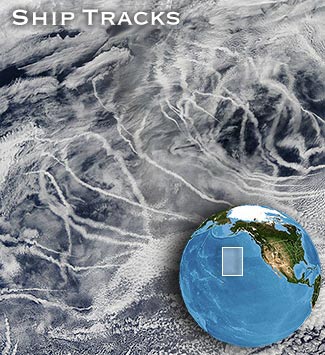As reported on our Earth Gate web page (weekly news ending July 16, 2010), “the white contrails left high in the atmosphere by passing jet aircraft have a maritime counterpart near sea level in at least some regions of the world’s oceans. The white streaks visible in the NASA image to the right were not caused by aircraft, but were instead left in the wake of ships at sea.
As the MODIS instrument orbiting on the Aqua satellite captured the image at midday on July 3, 2010, the ‘ship tracks’ from several vessels were hovering over the Pacific off the California and Oregon coasts. This is one of the most heavily traveled areas of the world for maritime shipping, with ships carrying cargo from ports along the West Coast to destinations in Asia and elsewhere around the world.
The ship tracks phenomena form when water molecules gather around the exhaust that ships release into the air. When enough water molecules collect, a visible cloud is created. Ship track clouds often have a long, rope-like appearance because they become stretched over a narrow path when blown by the wind. Such formations may remain visible for days until they are eventually dispersed by the wind.
The atmosphere has to be just right to allow the tracks to form. They are mainly visible only over parts of the eastern Pacific Ocean. Their appearances in the western Atlantic have been extremely rare, but they have occasionally been seen off the coast of Western Europe. Ship tracks can only form in a very clean air mass of Arctic origin. A temperature inversion is also needed at about 1,600 to 2,300 feet above the ocean’s surface, allowing the lower atmosphere to remain very stable with very little turbulence or upward motion of the air.”
A recent NASA study claims man-made cirrus clouds formed by commercial jet engine exhaust may be responsible for the increased surface temperatures detected in the United States between 1975 and 1994. According to NASA’s Visible Earth web site, “Because clouds represent an area of great uncertainty in studies of global climate, scientists are interested in better understanding the processes by which clouds form and change over time. In recent years, scientists have turned their attention to the ways in which human-produced aerosol pollution modifies clouds. One area that has drawn scientists’ attention is “ship tracks,” or clouds that form from the sulfate aerosols released by large ships. Although ships are not significant sources of pollution themselves, they do release enough sulfur dioxide in the exhaust from their smokestacks to modify overlying clouds. Specifically, the aerosol particles formed by the ship exhaust in the atmosphere cause the clouds to be more reflective, carry more water, and possibly inhibit them from precipitating. This is one example of how humans have been creating and modifying clouds for generations through the burning of fossil fuels.”




